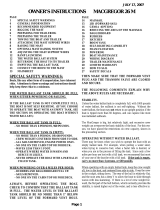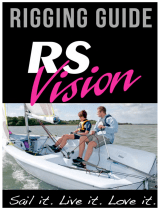
2
INTRODUCTION & DESCRIPTION CHANGES
Thank you for purchasing the AquaCraft
™
Vela! We want the time you
spend with your new R/C boat to be fun and successful so please
fully read the manual. If for any reason you think this R/C model
is not for you, return it to your local hobby dealer immediately.
Your hobby dealer cannot accept returns on any model after fi nal
assembly or after your boat has been operated.
All pictures, descriptions, and specifi cations found in this instruction
manual are subject to change without notice. AquaCraft maintains
no responsibility for inadvertent errors in this manual.
FEATURES & SPECIFICATIONS
BOAT FEATURES:
Prepainted lightweight fi berglass hull
Pre-assembled preprinted sails
Water-resistant radio hatch
Modern, 1-meter design
Tactic
™
TTX242 2.4G two-stick surface radio system
Tactic TSX382 sail winch servo (installed)
Tactic TSX rudder servo (installed)
Prefi nished wood boat cradle
Quick and easy fi nal assembly
BOAT SPECIFICATIONS:
Boat Specifi cations:
Hull Length: 40" [1016mm]
Beam: 6.5" [165mm]
Overall Height: 79" [2006mm]
Weight: 6lbs [2720g]
ITEMS REQUIRED
➧ Eight “AA” batteries
➧#2 Phillips
®
screwdriver
➧ 2.5mm hex wrench
➧ Grease (Grimracer cable grease, AQUB9500)
WARRANTY SERVICE
AquaCraft will warrant your Vela for 90 days after the purchase
from defects in materials or workmanship of original manufacture.
AquaCraft, at their option, will repair or replace at no charge, the
incorrectly made part. This warranty does not cover damage caused
by crash, abuse, misuse, alteration or accident. To return your boat
for service you will need to provide proof of purchase, i.e., your
store receipt or product invoice.
IN NO EVENT SHALL THE PURCHASER BE ENTITLED TO ANY
INCIDENTAL, SPECIAL, INDIRECT OR CONSEQUENTIAL DAMAGES,
WHETHER RESULTING FROM THE USE, MISUSE OR INABILITY TO
USE THE PRODUCT OR FROM DEFECTS IN THE PRODUCT.
This warranty gives you specifi c legal rights and you may also
have other rights, which vary from state to state. Outside USA and
Canada, contact local importer for warranty information.
Hobby Services
3002 N. Apollo Drive, Suite 1
Champaign, Illinois 61822
Attn: Service Department
Phone: (217) 398-0007 9:00 am - 5:00 pm Central Time M-F
SAFETY PRECAUTIONS
➧ Never, ever, attempt to swim after a stalled R/C boat. DO NOT
get in the water for any reason to retrieve your boat. Your Vela
has fl otation added to the interior of the hull and will not sink.
To aid you in retrieving a stalled R/C boat you can use a fi shing
real with a tennis ball tied to the end of the line. Or better yet get
yourself a small jon boat so you can row out and pick up your boat.
Remember to use a PFD any time you enter your retrieval craft.
➧ AquaCraft products are to be used by ages 14 and over.
➧ The speed and mass of this boat can infl ict property damage and
severe personal injury if a collision occurs. Never run this boat
in the presence of swimmers or where the possibility of collision
with people or property exists.
➧ This boat is controlled by radio signals, which are susceptible to
possible interference from electrical noise.
➧ If your Vela should happen to loose signal, wind and water currents
will slowly carry it to shore. The bad news is that the boat could be
carried to the opposite shore. When surveying areas to run your
model, keep variables in mind such as wind direction, size of the
lake, etc. It is not advisable to run R/C boats on any free-fl owing
bodies of water such as creeks or rivers.
























